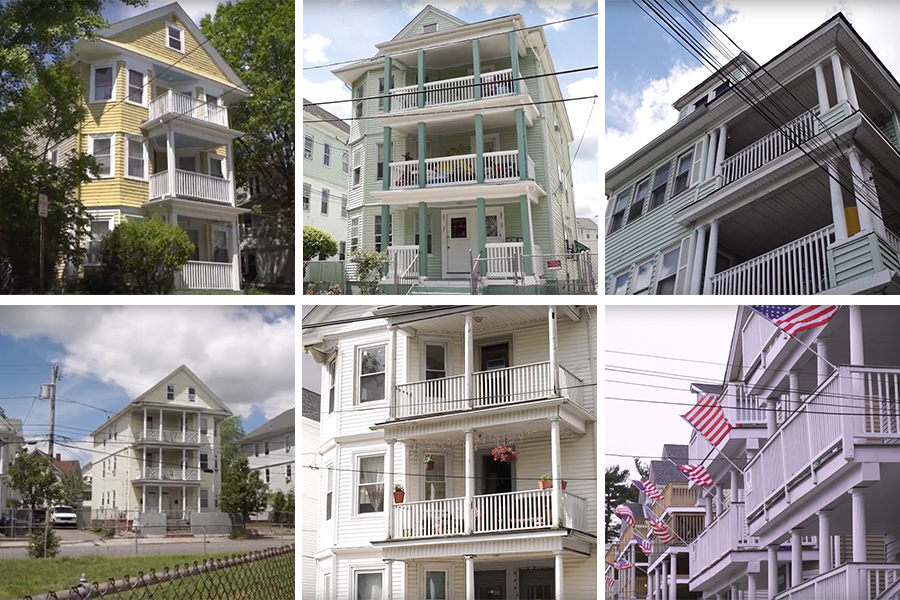A New Documentary Explores New England’s Love for Triple-Deckers
Filmmaker Marc Levitt is celebrating the region’s iconic housing units with Triple Decker: A New England Love Story.

Images via Triple Deckers: A New England Love Story
They line the roads of Boston’s streetcar suburbs, the hills of Worcester, and the streets of Providence. Triple-deckers (or three-deckers, if you prefer) are a ubiquitous sight unique to New England. So to visitors and non-natives, their layer cake-like design is a distinct deviation from the region’s time-honored Capes and Colonials.
Filmmaker Marc Levitt, like many transplants, immediately noticed the prevalence of triple-deckers when he moved to Rhode Island from New York City in the 1970s. Intrigued, he researched the strange-looking buildings, and became fascinated by their immigrant history. Now, after a decades-long love affair with the structures, Levitt is setting out to share their love story with New England.
His forthcoming documentary, Triple Decker: A New England Love Story, will dive into the history of the region’s three-story tenements and their inhabitants. Levitt, whose prior works include Stories in Stones, a documentary about Narragansett tribal stonemansons, is in the process of interviewing dozens of longtime triple-decker residents. He hopes to celebrate the iconic buildings by gathering stories from the immigrants and working-class people who grew up in them. The film will highlight triple-deckers in cities and neighborhoods where they’re highly concentrated, including Dorchester, Mattapan, Worcester, Providence, Woonsocket, New Bedford, Lawrence, Fitchburg, Manchester, and Lewiston.
Levitt’s love story is organized into six chapters that parallel a stage of love and intimacy. Its timeline begins in the late 1800s with a section about infatuation, detailing the initial attraction of triple-deckers. It evolves into how they became homes for immigrants, looking at how the buildings created supportive communities within and across ethnicities. By the “conflicts” chapter, viewers learn about triple-deckers as targets for anti-immigration sentiment, while the fifth chapter provides an overview of their decline and destruction due to factors like fires, highway construction, and suburbanization.
The story, of course, does not end in destruction. Its last chapter is meant to offer a critical look at the gentrified state of triple-deckers today. Thanks to their economical model that allowed owners to rent out floors to family members and other tenants, the homes were once havens of affordability. But today, about a century after many triple-deckers were constructed, triple-deckers are no longer home to thriving working-class communities. They’ve been subdivided into high-priced condos in recent years. The condo-ization of triple-deckers in neighborhoods like Dorchester, says Levitt, goes precisely against what they stand for.
“It’s a modern variant on the theme of a triple-decker, but without what triple-deckers really represented: affordability and creating collective identities and neighborhoods,” he says. “Because what you have in Boston is basically the individuation of a collective housing unit. Condominiums are very much a private property and private enterprise, and anybody you speak to about triple-deckers will talk about living in a mock collective in some ways.”
Indeed, the past and present residents Levitt has already interviewed since beginning the project in 2017 all speak to the close-knit nature of the housing unit, describing the groups of relatives who lived on each floor of their home.
“Twelve kids in one house. Couldn’t get any better. Loved it,” says a Providence resident in the film’s trailer.
Another woman reminisces about living in a Providence triple-decker owned by her Italian grandparents, along with her aunt, uncle, parents, brothers, and sisters.
“When you walked through the neighborhood, the houses were close enough to the street, the windows were open—you could smell the meats that had been cooking in the sauce,” she says.
Levitt hopes to celebrate the architecture of triple-deckers by portraying the aspects of everyday life that played out in them.
“The triple-decker lent itself to all kinds of interesting ways in which culture was preserved and culture was formed. To me, that’s a fascinating element of the film, and an element that people don’t really understand,” Levitt says. “They see a house as a noun rather than a verb. And a triple-decker is definitely a verb.”
Work on the 60-minute documentary is underway, and its release date has not yet been established. Levitt is still fundraising for the film on Indiegogo, and is interested in hearing from more people who have lived in triple-deckers. Prospective interviewees are encouraged to visit the film’s Facebook page.
“Triple-deckers are too often perched on the precipice between gentrification and disrepair,” says Levitt in the film’s trailer. “So we’ve got to show the world right now that lives of creativity and determination happened as much on the floors of triple-deckers as in any Queen Annes or Victorians.”


